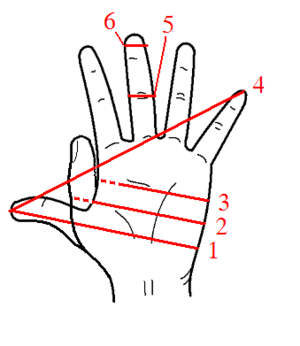Span (unit) facts for kids
A span is a way to measure distance using your own human hand. It's the length from the tip of your thumb to the tip of your little finger when your hand is stretched out. Long ago, people thought a span was half of a cubit, which was another old measurement.
Sometimes, people talk about two types of spans:
- The great span or full span goes from your thumb to your little finger.
- The little span or short span goes from your thumb to your index finger, or from your index finger to your little finger.
Contents
History of the Span Measurement
People have used the span as a way to measure things for a very long time! Ancient Greek writings show that the span was a common measurement in ancient Greece even before 500 BC. The Greek word for "span" is spithame. This word was used by a famous historian named Herodotus in the 5th century BC. Even earlier, around the 8th century BC, the word trispithamos (meaning "three spans long") appeared in the writings of Hesiod. This shows how old this measurement really is!
How Big is a Span?
The exact size of a span can be different depending on where you are in the world and whose hand is being measured. It's not a fixed, standard unit like a centimeter or an inch, but more of a traditional or informal measurement.
Span in English-Speaking Areas
In places that use English units, a span was often thought to be:
- 9 inches
- About 22.86 centimeters
Spans Around the World
Many different cultures have used their hands to measure things. Here are some examples:
- China: In China, a span (called 一拃) is usually the distance from the tip of the thumb to the tip of the stretched-out index finger (or sometimes the middle finger). It's typically about 15 to 20 centimeters.
- Arabic Countries: In Arabic-speaking countries, the great span is known as šibr.
- Slavic Countries: In Slavic languages (like Russian or Polish), words similar to ped or piad are used. These can mean the distance from the thumb to the little finger or the index finger. For example, in Slovenian, velika ped (great span) is about 23 cm, and mala ped (little span) is about 9.5 cm.
- Africa: In Swahili, the great span is called shubiri or shibiri, while the little span is morita or futuri.
- Hungary: In Hungarian, the span is called arasz. There's a "small arasz" (thumb to index finger) and a "large arasz" (thumb to little finger).
- South Asia: In countries like India and Pakistan, the span is a common informal measure. It's called bālisht in Hindi-Urdu, bighāt in Bengali, and weet in Marathi. In Nepal, it's called bhitta, and in Tamil, it's saaN.
- Southeast Asia: The span is also used informally here. It's called jengkal in Malay and Indonesian, khuep in Thai, and dangkal in Filipino.
- Mongolia: In Mongolia, the traditional span is called tuu. Depending on which fingers are used, it can have slightly different names.
- Portugal: In old Portuguese measurements, the span was called palmo de craveira or palmo. One palmo was about 0.22 meters.
See also
- Anthropic units
- Hand (unit)
- List of human-based units of measurement
- List of unusual units of measurement
- Units of measure
 In Spanish: Palmo para niños
In Spanish: Palmo para niños


